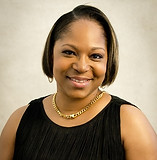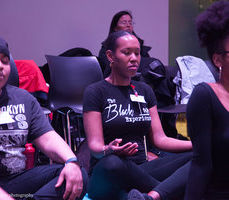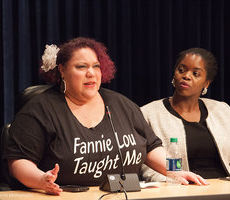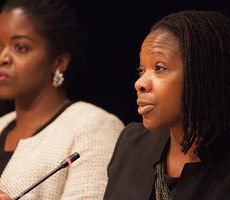
#SAYHERNAME: AN ACTIVIST HAPPY HOUR WITH AAPF
BUSBOYS AND POETS
Monday, March 26, 2018

#SAYHERNAME: POLICE VIOLENCE AT THE INTERSECTIONS OF OPPRESSION FOR BLACK WOMEN
(3 VIRTUAL EVENTS)
Tuesday, March 27, 2018
The forces of structural racism and sexism are multifaceted and impact Black women in a multitude of ways across various sectors. However, one through-line is the way in which Black women’s interactions with the state often turn violent and are sometimes fatal. Homelessness, gender policing or mental illness can lead to fatal interactions with police and other state actors.
As part of #HerDreamDeferred: A Week on the Status of Black Women and Girls, the African American Policy Forum and the Transformative Justice Coalition held 3 virtual events on Tuesday, March 27 to explore these varied dynamics of oppression and violence.
Igniting Change with Barbara Arnwine
TJC founder, Barbara Arnwine, hosted AAPF co-founders Kimberlé Crenshaw and Luke Harris on her radio show, Igniting Change with Barbara Arnwine for an update of the #SayHerName Campaign. They were joined by several family members of the #AayHerName movement. The entire program can be listened to here.
#SayHerName twitter storm & town hall
Following the radio show, AAPF and other racial and gender justice organizations hosted a 2 hour long twitter storm & town hall to continue the conversation.
NowThis News Video
The day concluded with the release of NowThisNews's brand new video on #SayHerName. We encourage you to watch it and share with friends!
RECOVERING HARRIET: AN INTERACTIVE EVENING OF ARTS AND ACTION FOR WOMEN OF COLOR
Wednesday, March 29, 2018
When you hear the name Harriet Tubman, what do you think of? Do you think of a woman who led hundreds of slaves to freedom? What about a nurse, spy, scout and tactician for the union army? Harriet Tubman was all these things and much more. However, much of her life was spent in dire economic straights working in white families’ homes to support herself and her family. Only after years of agitation was she able to receive a military pension to support herself. Yet, the pension was not given to her as Harriet Tubman, Moses, the conductor of the underground railroad, the general, or an army medic, but rather as the wife of private nelson, a soldier in the union army.
On Wednesday, March 28, from 5:30-10:00 p.m. we brought together 50 women of color of all ages for Recovering Harriet: An Interactive Evening of Arts and Action, a night of arts workshops led by AAPF’s renowned teaching artists. Recovering Harriet connected performance to activism and history in attempt to reground Harriet Tubman's legacy in her heroism and devotion to justice.
Teaching Artists:

Abby Dobson is AAPF's Artist-In-Residence. A Sonic Conceptualist Artist, Dobson’s sound is the alchemy of R&B/Soul, jazz, classic pop, gospel, and folk, forging a gem that erases musical boundaries. Abby has performed at venues such as S.O.B's, Kennedy Center Millennium Stage, Apollo Theater, Blue Note Jazz Club, and The Tonight Show (Jay Leno). Her debut CD, "Sleeping Beauty: You Are the One You Have Been Waiting On” was released in 2010 to glowing reviews. Abby received a Juris Doctorate degree from Georgetown University Law Center and a Bachelor’s degree from Williams College in Political Science and History. An independent scholar, Abby’s research interests focus on the intersection of race and gender in the imagination, creation, consumption, and distribution of music. Passionate about using music as a tool for empathy cultivation, Abby creates music to privilege black female voices and highlight the human condition. She is committed to shining her artistic light - volunteering with the African American Policy Forum and the National Organization for Women, NYC Chapter. www.abbydobsonsings.com

Hazelle Goodman, a native of Trinidad and Tobago, is a one-woman powerhouse. Her unique ability to transform into many different characters has propelled her to the forefront as a multi-dimensional actress. Featured in Vogue, People and Vibe magazines, her self-titled HBO Special received unprecedented ratings and was nominated for two Cable Ace Awards – Best Comedy Special and Best Performer. Among her many credits, Ms. Goodman starred opposite Woody Allen in the groundbreaking role of “Cookie” in Allen’s Deconstructing Harry, as the diva, drug lord, “Georgia Rae Mahoney” on NBC’s Homicide, and as Evelda Drumgo in the blockbuster film Hannibal. Recently Ms. Goodman appeared in Extremely Loud and Incredibly Close starring Tom Hanks. People magazine calls the actress "sinfully good," and Time Out New York declares her "a memorable comic gem."

Afia Walking Tree, M.ED is a world-class cultural ambassador, spiritual activist, empowerment guide, leadership development advocate, and trainer. Born and raised in Kingston, Jamaica. Walking tree’s drum-songs are prayers of gratitude for the generosity of spirit. Her lyrics are evolutionary teachings, addressing present-day issues of social justice, freedom, healing, and self-love. For over 25 years, Afia Walking Tree has served her destiny as visionary director of her brainchild, spirit drumz, an international organization that prioritizes women and youth of all cultures to utilize African diasporic song, permaculture, drumming, dancing, storytelling to activate empowerment and healing. Afia's work has always been rooted in liberation of the global black family and in the last two years, in response to the black lives matter movement, Afia has created new spaces for black healing and activism through the Jamaican drum retreats for womyn, and #blackpowerdrummedicine. Afia's continued evolution is supporting the growth of the drumming arts as a tool for activism, healing and community building through partnerships with One Billion Rising, Echo Valley Farms, Open Meadows Foundation, and many others. Afia has been blessed to bring her powerful work to bioneers, Northern California Permaculturre Convergence, TedWomen 2016 and numerous, festivals, non-profit organizations, and universities across the globe.

Dina Wright Joseph, Program Manager of Purelements: An Evolution in Dance, began her dance training at the age of five at Adele’s Creative Dance Center in Queens, NY. With the loving support of her parents, she continued her training in classical ballet until her audition and acceptance to the dance program at the prestigious LaGuardia High School of Music and the Performing Arts. During her freshman year at LaGuardia, Dina turned down a partial scholarship at the School of American Ballet to accept full scholarships to the Alvin Ailey American Dance Center and the Martha Graham School. Dina’s training and dance vocabulary expanded triple-fold when introduced to West African dance and music while apprenticing with Forces of Nature Dance Theater Company in 1989. For the next 12 years, under the tutelage of directors Abdel Salaam, Dyane Harvey-Salaam, and Dele Husbands, she toured both nationally and internationally as a principal dancer and dance captain with the company until 2001. Theater credits include The Wiz, For Colored Girls…, St. Louis Woman, and Dance Captain for the New York Shakespeare Company’s production of Measure for Measure. Dina is the proud recipient of the FON Artistic Acheivement Award and has graced the cover of Heart and Soul magazine, and Instyle magazine’s featured article entitled, Dina Wright: A Force of Nature. Dina’s television credits include PBS' "Free to Dance" and VH1’s "Divas Live" with Aretha Franklin. She co-choreographed VH1’s "Hip Hop Honors" tribute to Afrika Bambattaa and is featured in the Smithsonian Museum's multi-media installation, "Black Dance in the 20th Century". In addition to her performance career, Dina’s passion to inspire youth and future artists was emboldened as her focus intensified in the areas of dance education and teaching artistry. Dina began her teaching career in Mexico City, New Mexico and between years 1999-2006, Dina served as Dance Program Director at Eastside Community High School as well as choreographer for Mindbuilders’ Creative Arts Center’s youth theater company, Positive Youth Troupe. From 2003-2005 she served as guest lecturer for Lehman College's City and Humanities Dept. as well as lead teacher for NYCDOE's Summer Arts Institute in partnership with Roundabout Theatre. Dina currently sits on the faculty of Professional Performing Arts High School, Alvin Ailey’s Fordham BFA Program, and on a team of master artists of Arts In Motion: Africa. Her most rewarding position to date is as founding member and Program Manager for Purelements’ Project AIRE arts-in-education program leading a team of thirty-four Teaching Artists and Art Educators inspiring upward of 10,000 NYC students per year.



HARRIET'S DAUGHTERS:
AN EVENING OF CONVERSATION AND CELEBRATION
Thursday, March 29, 2018
When we hear the name Harriet Tubman, we think of a woman who led hundreds of slaves to freedom during the civil war. We may recall that she was also a suffrage activist, an army medic, a gifted tactician, and the first woman ever to lead an armed expedition for the u.s. Army.
What many people don’t realize is that despite her unparalleled achievements, she spent her final years in dire economic straits, working in white families’ homes to support herself and her family. Although she served as a spy for the Union Army, she was not able to get a pension in her own right for her service to her country. After years of agitation, Tubman, at last, received a pension—not as Harriet Tubman, Moses, the conductor of the underground railroad, the general, or an army medic, but as the wife of private nelson, a soldier in the union army.
A century after her death, what we can learn from Harriet Tubman's refusal to adhere to the limits placed on her race and gender by society? How has her legacy inspired and informed black women who came after her, such as Rosa Parks, Recy Taylor, Ida B. Wells, Pauli Murray, and Shirley Chisholm? In what ways do women and girls of color continue to be erased from contemporary racial and gender justice agendas?
Tracing a history of race-centered and gender-centered social movements, from the millions man march to the women’s suffrage movement to #MeToo, Harriet's daughters featured a keynote talk by Kimberle Crenshaw, a theatrical production exploring Harriet's life and legacy through music, dance, and drumming, a panel discussion with Barbara Arnwine, Tatyana Fazlalizadeh, and Samantha Master, and a reception with engagement stations for deeper connections to Harriet’s legacy.

FROM BIRTH CONTROL TO DEATH:
FACING BLACK WOMEN'S MATERNAL MORTALITY
Friday, March 30, 2018
America has the highest maternal mortality rate of any developed nation, according to the world health organization which found that between 700 - 1200 women died in the united states each year from pregnancy or childbirth complications. The united states’ maternal mortality rate has more than doubled since 1990, climbing from 12 to 28 deaths per 100,000 births.
We know that not all women are equally impacted by this phenomenon. According to NPR and ProPublica, Black women are 243% more likely to die from childbirth than white women. However, what many do not realize is that Black women’s vulnerability to maternal mortality is not a class-determined issue. Factors that contribute to pregnancy and childbirth complications include damaging stereotypes about black women’s strength and resiliency, and the pervasive notion that their pain is less real than that of their white women counterparts - factors that impact all black women regardless of their socioeconomic success, academic achievement, and overall health and wellness. One need looks no further than Serena Williams’ harrowing account of the health complications she experienced giving birth to her first child last September to see that wealth, fame, and achievement cannot shield one from the effects of racism and sexism.
As much as Black women have been valorized for their strength, we must recognize the elements of this myth that constitute relics of slavery. The indestructibility of Black women has long been an excuse for overwork and underprotection, a rationalization for our exploitation and abuse that has morphed into a dangerous stereotype that we have all too often internalized. These assumptions gravely imperil and undermine black women’s health, both mental and physical, and lead to higher rates of heart disease, strokes, and maternal mortality.
Black women are also disproportionately subject to various deleterious conditions, such as poor-quality environments in impoverished neighborhoods, food deserts, and a lack of access to healthcare — conditions that make them more susceptible to life-threatening diseases such as HIV and cancer. Moreover, there are drastic gaps in access to culturally-competent healthcare for Black women, meaning the diseases they contract are more likely to be lethal. While Black women have a lower rate of breast cancer diagnosis than white women, they have a drastically higher rate of mortality as a result of the disease. As the data show, Black women’s health in the US is in a state of crisis. Simply put, black women die earlier deaths than their white counterparts because they are women who are Black.
On March 30th at the Barbara Jordan conference center in Washington DC, we held our closing panel of #HerDreamDeferred 2018: From Birth Control to Death: Facing Black Women's Maternal Mortality. The panel explored the ways in which stereotypes around the invincibility of Black women, their environmental circumstances, and the gaps in culturally competent health care all intersect and interact to endanger Black women in specific and extreme ways. The panel was moderated by AAPF executive director, Kimberlé Crenshaw, and featured leaders in the field of black motherhood: Laurie Bertram Roberts, Dr. Joia Crear-Perry, Avis Jones-Deweever, Jennie Joseph, Aarin Michele Williams, and Kira Shepherd.

































































































